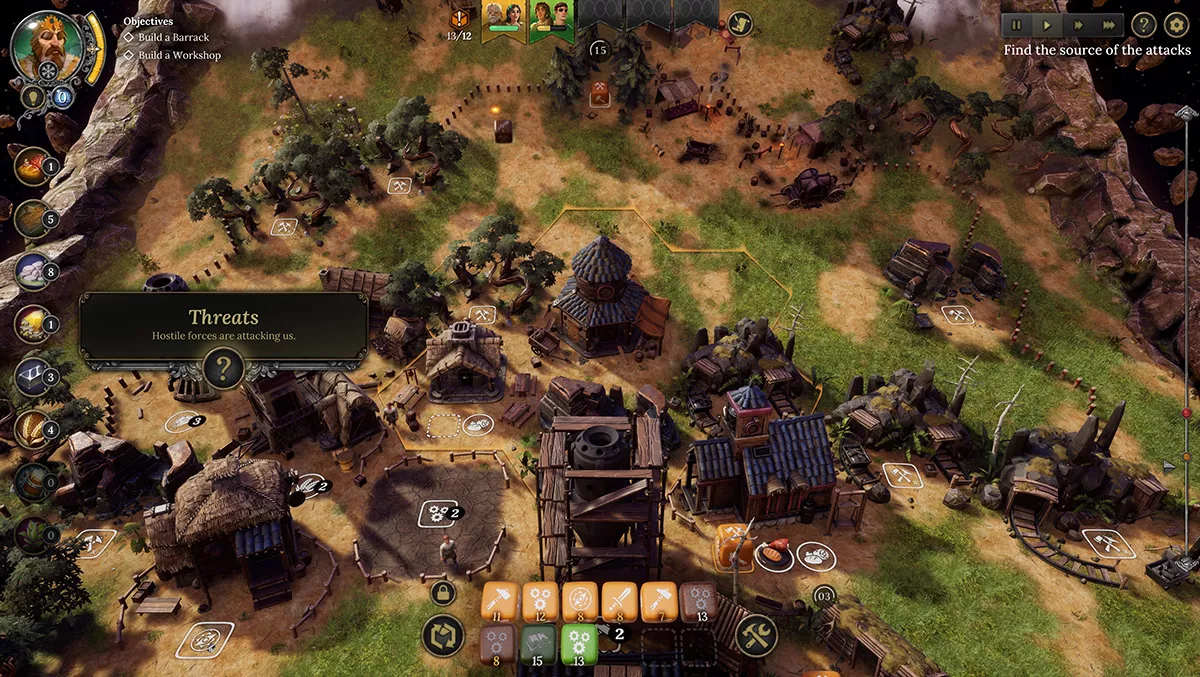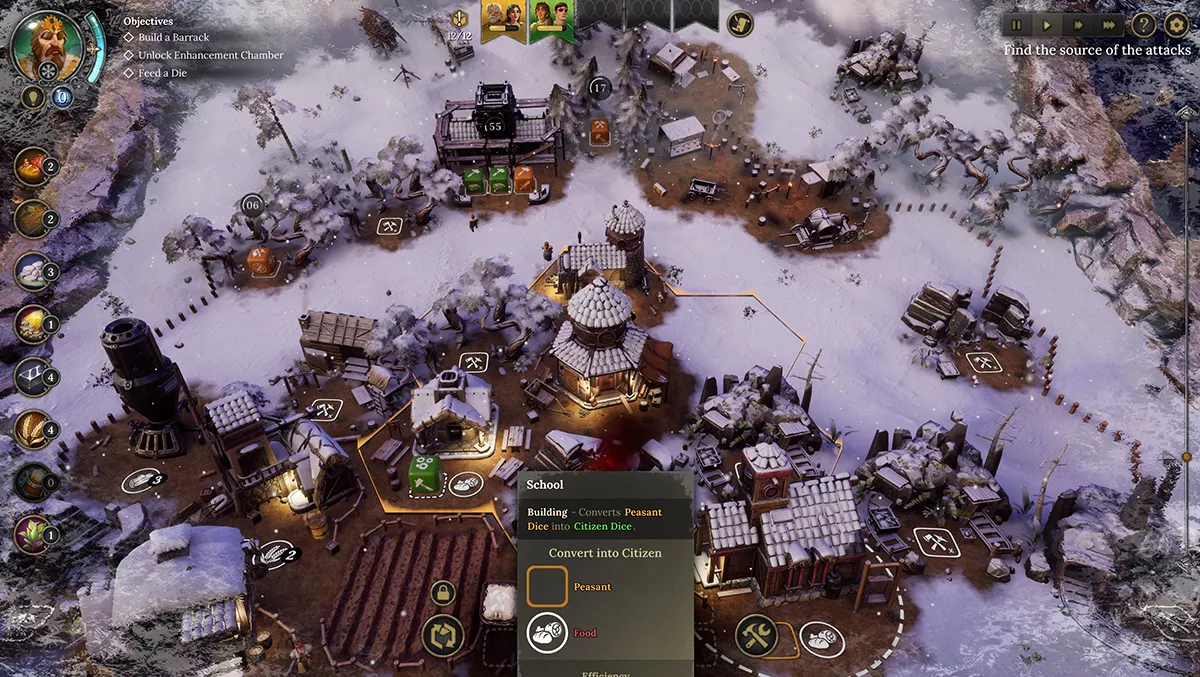
Game review: Dice Legacy (PC)
Dice Legacy is a city-building, resource collecting, real-time strategy game with a difference.
The game starts with a sailing ship approaching a landmass that is part of a ringed halo-like structure. Upon disembarking, the player is set the task of building a settlement.
By the port is a single structure, a cookhouse, an essential building for reasons I'll go into later. There's also some cargo, trees, mines, quarries, glades, and hunting areas.
Players of games like the Age of Empires series will be intimately familiar with the resource collection element of the game. You need resources for everything. Initially, that's food, wood, stone, and metal, but later on gold, herbs, wheat, and beer.
At the bottom of the screen are twelve squares, six of which are filled with orange dice. These are peasants. Each peasant die has six different faces. Each face represents a task that it is capable of doing. That's working, gathering, building, fighting, and exploring. Just as in real life, they are the backbone of your society.

The basic mechanic of the game involves assigning dice to tasks befitting the type of work shown on the top face. Pressing the spacebar rerolls the dice allowing spent dice to be used again and dice that were not used potential be assigned different tasks. Dice only have finite durability one point of which gets lost with every roll. When the durability reaches zero, dice will die and be removed from the screen. This is where the cookhouse comes in: placing a die in the cookhouse with a portion of food replenishes the die's durability. It's an ingenious game mechanic that makes chance a factor.
The game runs in real-time; each task takes an allotted time to complete. More dice equals more tasks that can be undertaken. For example, building houses and placing two peasant dice in them creates another peasant. This can be used to generate up to 12 dice. Players will want to max out the dice as soon as possible. At first, I found the micromanagement of 12 dice to be a bit overwhelming, and it took a while to get into the rhythm of rolling and assigning takes whilst keeping an eye on durability.
As the game progresses, more buildings become available, enabling the creation of citizen dice, military dice, merchants, priests, and mercenaries. All are very useful, but still, with that 12 dice limit, care must be taken. As well as their specialities, most dice can still carry out essential tasks such as gather and build if that face is rolled; some, such as the citizen can do work as well.
The size of the player's settlement is expanded by building district halls. Districts can then be allocated a die type (peasant, citizen, etc.). This allows for special boosts and policy advantages for that particular die type.
The camera scrolls around the halo within the area of the settlement. The settlement can become quite cluttered, making it difficult to see which building is which. Hoovering over a building makes the surrounding buildings transparent, but it's still not easy. As the settlement advances inland and the resources to the bottom of the screen get exhausted, there's a need to manage buildings, destroy them, and rebuild closer to the 'front line' to avoid frantic scrolling when things get busy.
Whilst the number of dice is finite, they can be enriched to do the work of multiple dice. This speeds the game up as players make their way further inland. The forge can also combine dice for special abilities and traits, some positive and some negative.
The technology tree is unlocked by using workshop buildings with the appropriate face of the citizen dice. The knowledge points gained can be used to improve gathering and unlock new buildings. The technology tree is very similar to that of other strategy games, complete with addition technology levels available to unlock.

There are other people on the landmass that will attack as the player progresses. The frequency of these attacks depends on the difficulty level. Some other settlements can be traded with or attacked.
The game world cycles between summer and winter. As the season change, players can choose to enact council policies that offer small advantages.
During winter, crops cannot be sown or harvested, and dice can freeze in the cold weather, making them unavailable. At the beginning of the game, I found winter to be an absolute chore. Building steam generators and powering them with wood reduces the likelihood of freezing but doesn't stop it entirely. Later on, thanks to breweries and taverns, dice can be easily thawed out. Towards the end of the game, the seasons didn't really affect my game; I even had a council policy that let my fields continue to operate during the bad weather.
The end game is to expand your settlement to the top of the landmass. The victory condition is to destroy the enemy's port, making them retreat and leave the land in their ship. It may be worth holding off the final destruction of your enemy, though. Unlocking the obelisk allows for your best dice to be kept for use in subsequent games.
Finishing this scenario unlocks new leaders, each with their own advantages, and five alternative gameplay scenarios. The other scenarios feature the same landmass and victory conditions but with slightly different rules. These range from playing with only six dice to a larger enemy civilisation to fight. I was hoping that these unlockable scenarios had a bit more variety instead of being essentially the same map.
The game is impeccably polished. The graphics look really nice, and it has a great visual style. The user interface is very clean, even if the actual settlements can get a bit messy.
I went from feeling so-so about the game to really getting right into it. It's a simple idea with gameplay that seems a bit too simplistic at first, but becomes pretty involved, offering players a remarkable number of choices and strategies.
Dice Legacy is a unique game that takes the tried and tested formula of a hundred identical real-time-strategy games and adds a simple yet effective spin. The result is a game that, on the surface, looks a bit of a gimmick but becomes a deep and thoroughly enjoyable experience the more you play.
Verdict: 8/10


